Physical Address
304 North Cardinal St.
Dorchester Center, MA 02124
Physical Address
304 North Cardinal St.
Dorchester Center, MA 02124
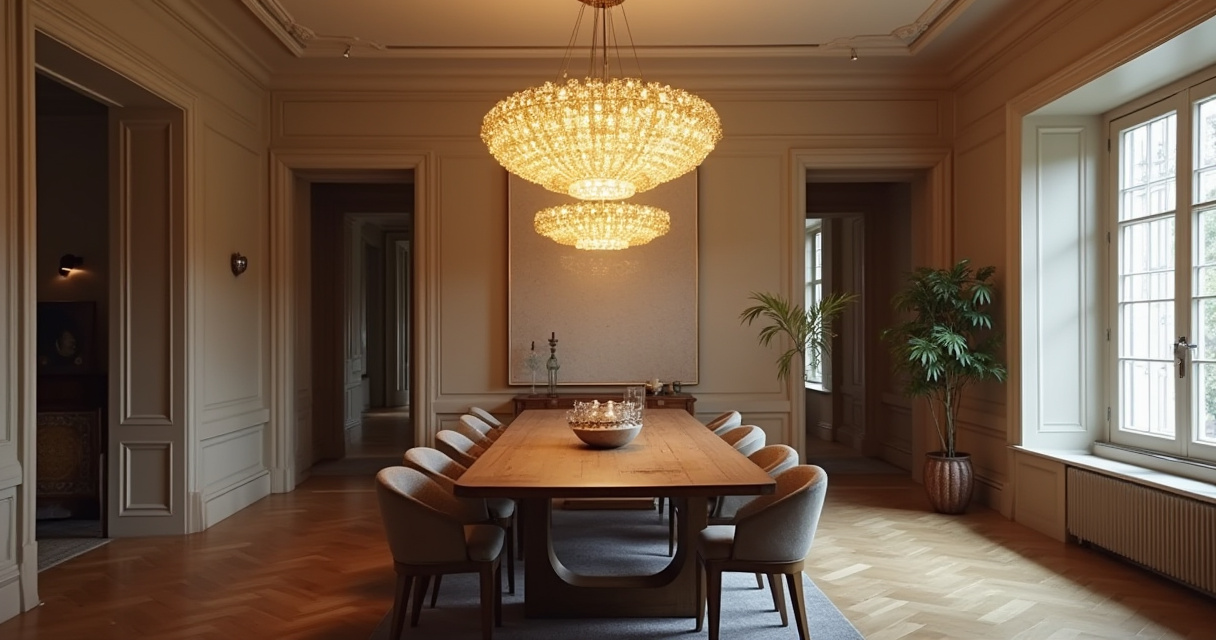
Discover 21 thoughtful dining room decoration ideas specifically designed for multi-generational homes, balancing functionality with beauty to create spaces where extended families can gather comfortably and meaningfully.
The dining room is where family stories unfold across generations – where grandparents share wisdom over steaming bowls of soup, where children announce their achievements, and where multiple generations gather to celebrate life’s milestones. In homes where extended families live together, this space needs special consideration.
As a specialist in multi-generational living spaces, I’ve seen how thoughtfully decorated dining rooms become the heart of family connection. These spaces must balance practicality with beauty, tradition with modernity, and most importantly, create an environment where everyone from toddlers to grandparents feels comfortable and valued. Let me share 21 dining room decoration ideas that honor the unique dynamics of extended family living while creating spaces of beauty and function.
A statement chandelier serves as both a primary light source and a significant decorative element that can reflect your family’s cultural heritage. It immediately draws the eye, acting as a focal point that defines the dining area and sets the tone for gatherings. Unlike other fixtures, a statement chandelier has the scale and presence to command attention while illuminating the faces of loved ones gathered around the table.
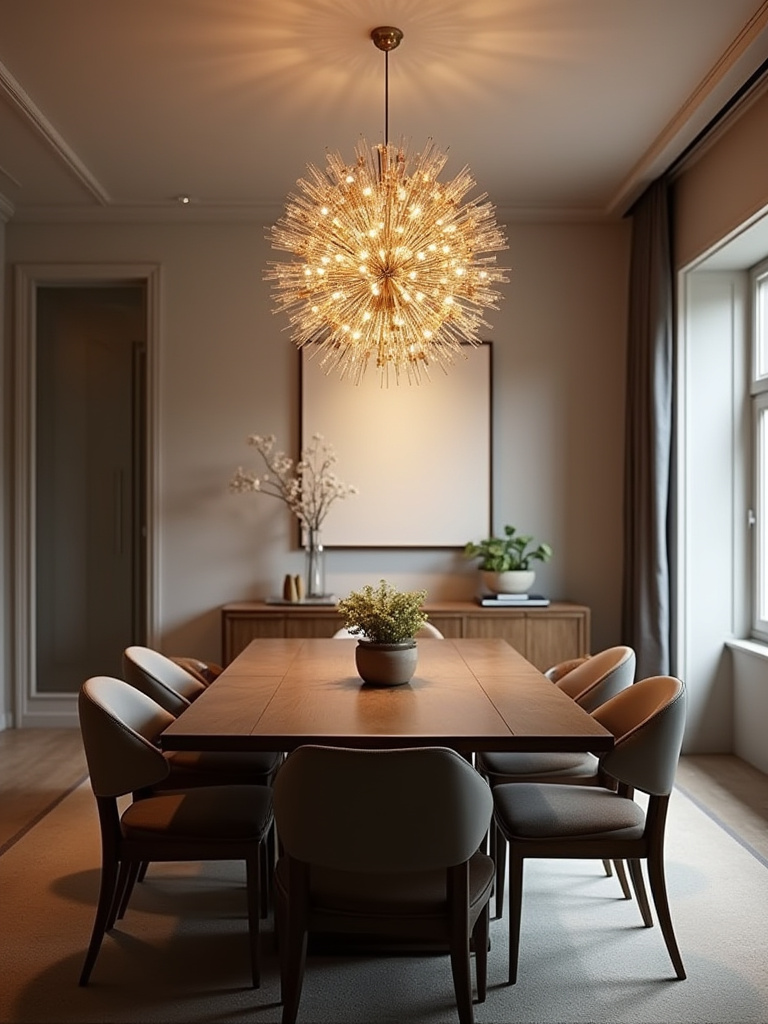
For multi-generational homes, consider chandeliers that incorporate elements meaningful to different age groups – perhaps combining traditional craftsmanship with contemporary styling. The right size is crucial – add the width and length of your dining room in feet, and that sum in inches gives you a good starting diameter. Position it so the bottom hangs approximately 30-36 inches above the table surface, ensuring it illuminates without obstructing cross-table conversation.
“The chandelier in our dining room incorporates brass elements from my grandmother’s original lighting fixture. Every time we gather beneath it, there’s a sense that she’s still presiding over our family meals.” – Maria L., homeowner
The inspiration for this collection struck when I visited a home where three generations gathered under a chandelier made from materials representing each family member’s heritage – copper for the Italian grandmother, rice paper for the Japanese mother, and modern LED elements for the tech-savvy grandchildren.
The ideal dining room rug should be large enough to allow all chair legs to remain on the rug even when pulled out, which is especially important in multi-generational homes where older adults may need extra space to maneuver walkers or wheelchairs. Add at least 30-36 inches to each side of your dining table’s dimensions to ensure adequate coverage and prevent tripping hazards.

In homes where different generations gather, durability becomes paramount. Consider low-pile wool rugs that resist staining while providing enough texture for secure footing. Synthetic options like polypropylene offer excellent stain resistance for homes with young grandchildren. While matching the rug shape to the table shape often creates visual cohesion, functionality should take precedence – rectangular rugs can provide more clearance around round tables for mobility devices.
The challenge of awkward spaces becomes easier when you think beyond conventional placement – consider how the rug defines the dining zone while accommodating the unique mobility patterns of each family member who uses the space.
A gallery wall in a dining room serves multiple meaningful purposes in multi-generational homes. It creates a visual family tree, honoring ancestors while celebrating current family members. Unlike living rooms dominated by televisions, dining rooms offer prime wall real estate for this family storytelling. A thoughtfully curated gallery can spark conversations between generations, helping younger family members connect with their heritage while older generations see their legacy preserved.

When creating a multi-generational gallery wall, consider mixing formal portraits with candid snapshots that capture authentic family moments. Include wedding photos from different eras, childhood images of now-elderly family members, and cultural artifacts that represent family heritage. The arrangement doesn’t need to be chronological – instead, create visual connections between similar moments across generations, like graduation photos or holiday celebrations that span decades.
The craftsmanship in this collection tells a story of family resilience – arrange photos that show how your family has overcome challenges together, creating a visual reminder of your collective strength during shared meals.
Choosing wall colors for a multi-generational dining room requires thoughtful consideration of how different age groups perceive and respond to color. While younger family members might appreciate bold, contemporary hues, older adults often prefer traditional, softer tones. Finding the balance point creates a space that feels both fresh and familiar, honoring different aesthetic sensibilities while creating a cohesive environment.

Consider colors with cultural significance that connect to family heritage – deep reds that might remind grandparents of traditional celebrations, blues that evoke cultural patterns, or earthy tones that ground the space in natural elements familiar to all generations. Whatever palette you choose, ensure adequate contrast between walls and furniture to assist those with aging eyesight. Testing colors under different lighting conditions is essential, as older adults may need up to three times more light than younger people to see the same level of detail.
“We chose a warm terracotta for our dining room walls after discovering it was the color of my husband’s grandfather’s childhood home in Mexico. It bridges our contemporary furniture with the traditional carved wooden chairs his grandmother brought when she immigrated.” – Carmen D., homeowner
What makes this design special is the way it honors both past and present – select colors that acknowledge family history while creating a fresh, welcoming atmosphere for creating new memories.
Window treatments in a multi-generational dining room must balance seemingly contradictory needs – older adults often need more light for visibility, while younger family members might prefer mood lighting for gatherings. The right window coverings provide crucial light control while addressing temperature regulation, which is particularly important as older adults and young children often have different temperature sensitivities.

Consider layered solutions that offer flexibility – sheer panels that diffuse harsh sunlight without darkening the room, paired with room-darkening side panels that can be drawn for evening gatherings. Motorized options can be particularly helpful, allowing family members with mobility limitations to adjust light levels independently. For homes where grandparents raise grandchildren, consider cordless designs that eliminate safety hazards while maintaining ease of use.
If you’ve struggled with similar rooms before, consider how window treatments can address multiple needs simultaneously – light control, privacy, temperature regulation, and aesthetic appeal – creating a space comfortable for all generations.
Historically, sideboards served as status symbols displaying a family’s finest possessions. In today’s multi-generational homes, they become command centers that bridge traditional storage with contemporary needs. Beyond housing china and linens, a well-chosen buffet can incorporate accessible storage for younger and older family members alike, with varying heights of drawers and shelves that accommodate different reach capabilities.

Consider how this piece can serve multiple functions – perhaps incorporating a charging station for grandchildren’s devices alongside display space for grandparents’ heirlooms. Look for models with varying heights of storage, placing frequently used items at levels accessible to all family members. Rounded corners provide safety for both young children and older adults who might brush against furniture, while sturdy construction ensures stability if someone needs to steady themselves.
“Our sideboard has become our family’s communication hub – the bottom drawers hold the grandkids’ art supplies, the middle section stores our everyday dishes, and the top displays photos and mementos. The surface serves as our message center where we leave notes for each other.” – James T., three-generation household
The unexpected environmental benefit comes from repurposing vintage sideboards, which often feature superior craftsmanship while connecting younger generations to family history through furniture that has witnessed decades of family gatherings.
Adding plants brings life and connection to the dining room, especially important in multi-generational homes where older adults may have limited outdoor access. Beyond aesthetic appeal, plants improve air quality and provide sensory stimulation through texture, scent, and visual interest. They can become shared projects that bridge generations – grandchildren watering plants while grandparents share plant care knowledge passed down through generations.

Select plants that hold cultural or family significance when possible. Consider low-maintenance options like snake plants or pothos that require minimal care yet provide maximum benefit. Strategic placement matters – large floor plants can define areas without creating barriers, while small potted herbs on windowsills can engage multiple senses and even contribute to family meals. For families with very young children or pets, ensure all plants are non-toxic and positioned securely.
Many homeowners wonder how to incorporate nature meaningfully – try creating a “heritage plant corner” where cuttings from family gardens are propagated and displayed alongside photos of the original plants in family members’ previous homes.
Styling a dining table with linens in a multi-generational home offers a beautiful opportunity to weave family history into daily life. Traditional textiles from different cultural backgrounds can be incorporated alongside contemporary pieces, creating layers of meaning beyond mere decoration. Hand-embroidered napkins passed down through generations, table runners featuring traditional patterns, or placemats made from fabric with cultural significance all contribute to a rich tapestry of family identity.
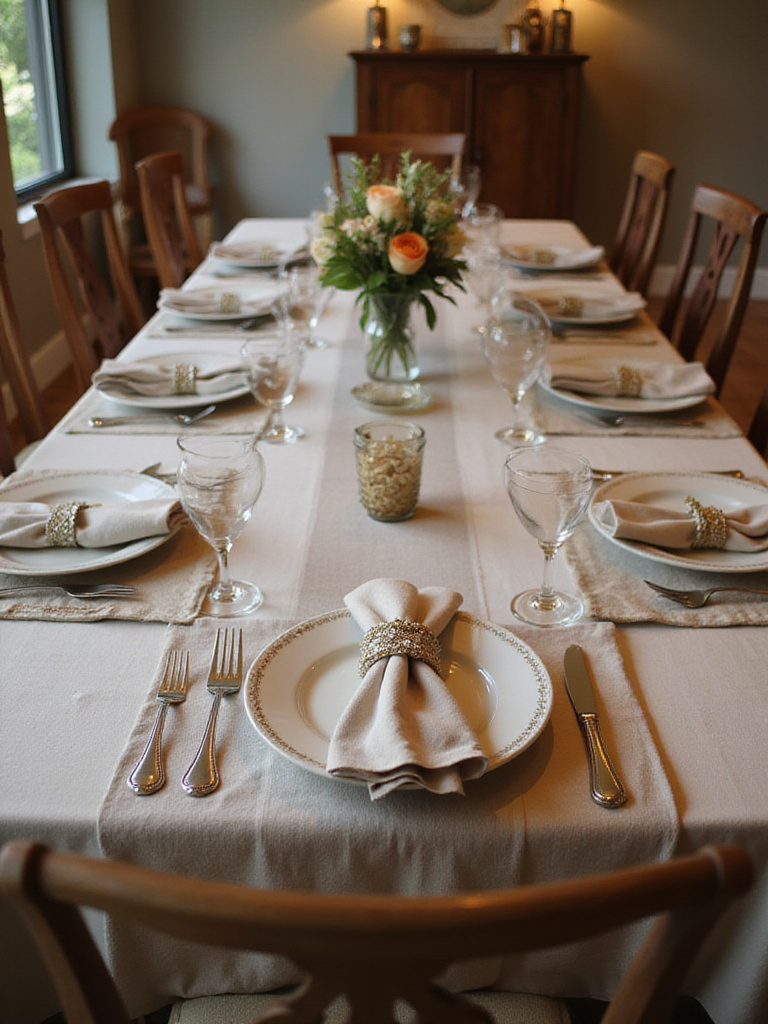
Consider creating a collection of linens that can be rotated for different occasions – perhaps grandmother’s lace tablecloth for special celebrations, washable cotton placemats for everyday meals with young children, and textiles that represent different branches of the family tree for heritage celebrations. The material choices should balance preservation of heirlooms with practical considerations for a household spanning multiple ages – perhaps displaying precious vintage linens in ways that protect them while using durable, washable options for daily use.
The styling mistake most people make is treating heirloom textiles as too precious to use – instead, incorporate them thoughtfully into family meals, allowing their stories to be shared across generations while creating new memories with these tangible connections to the past.
Mirrors work magnificently in multi-generational dining rooms by serving both practical and aesthetic purposes. For older adults, strategically placed mirrors can increase visibility of the entire room from seated positions, reducing the need to turn fully around. For those with hearing impairments, mirrors provide visual cues about activities happening behind them. Meanwhile, the traditional benefit of making spaces appear larger helps accommodate the various mobility aids and extra seating often needed in homes where extended families gather.

The ideal placement in multi-generational homes often differs from standard decorating advice. Consider positioning mirrors at varying heights to serve different family members – perhaps a full-length mirror near the entrance for those who want to check their appearance before meals, alongside lower mirrors that reflect the table surface for those who remain seated. Mirrors placed opposite windows maximize natural light, which particularly benefits older adults who may need additional illumination for comfortable dining.
“The large mirror in our dining room has become known as ‘Grandmother’s supervision mirror’ because it lets her keep an eye on the grandchildren at the kids’ table without having to turn around constantly.” – Sophia K., multi-generational home resident
The interplay between the colors creates unexpected benefits when you position mirrors to reflect not just light but meaningful family interactions, allowing everyone to feel more connected to conversations happening across the room.
Mixing and matching dining chairs in multi-generational homes isn’t just stylish – it’s essential for addressing diverse physical requirements. This approach allows you to incorporate chairs with arms to assist older adults with sitting and standing, higher seats for those with mobility challenges, and standard-height seating for other family members, all while maintaining a cohesive look. The practical benefits of customized seating combine with the visual interest of a thoughtfully curated collection.

Success in mixing chairs for multi-generational dining requires attention to both function and form. Maintain a consistent seat height for all adult chairs (typically 18-20 inches from floor to seat) while varying the back heights, arm styles, and support features. Consider upholstered options for older adults who may sit longer during meals, armchairs for those needing stability, and lightweight options that can be easily moved by family members with less strength. Unify diverse chairs through consistent elements – perhaps the same wood tone, complementary fabrics, or a color palette that ties to your cultural heritage.
When clients ask us about balancing style with comfort, we recommend starting with needs assessment – have each family member test different chair styles to determine what features provide the best support for their specific requirements, then build your collection around those essential pieces.
The primary purpose of a dining table centerpiece in multi-generational homes extends beyond decoration – it becomes a conversation starter that bridges age gaps. Thoughtfully selected centerpieces can showcase family history, highlight cultural traditions, or feature elements that engage different generations. Unlike purely decorative arrangements, these centerpieces serve as physical anchors for shared stories and collective memory.
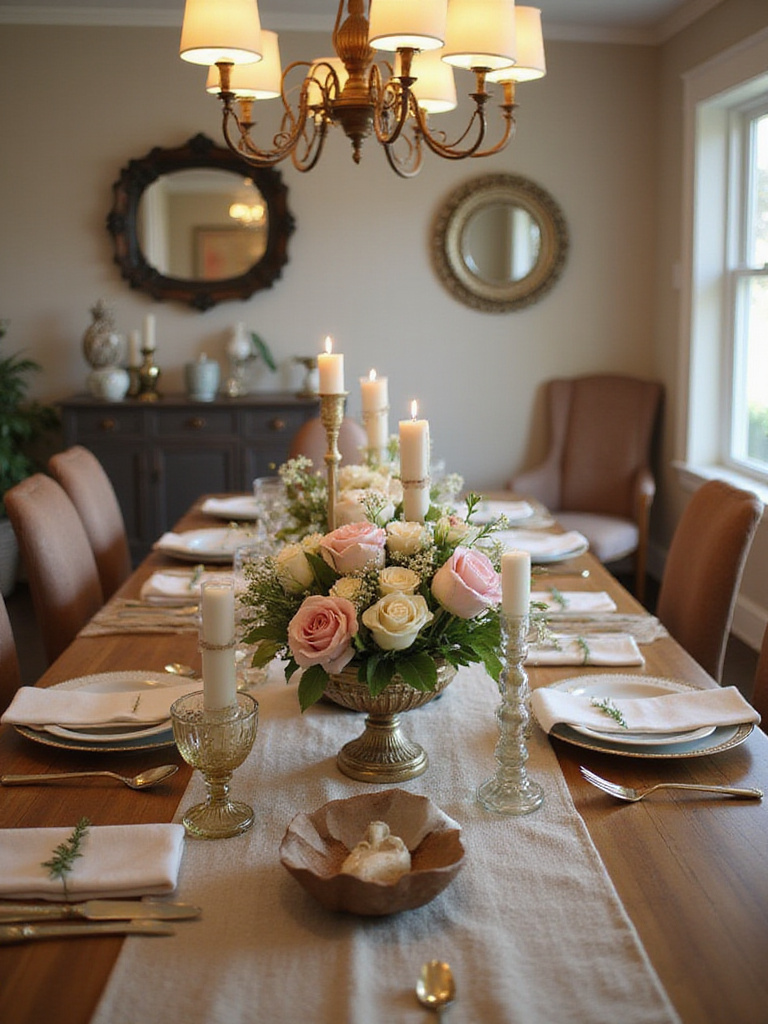
Consider rotating centerpieces that feature family artifacts with stories attached – perhaps grandmother’s collection of vintage salt cellars one week, a child’s recent craft project the next, and cultural items related to upcoming holidays or celebrations another time. Height remains important – keep arrangements low enough for cross-table visibility and conversation, generally below 12 inches. For families with young children, ensure stability and avoid small pieces that could present choking hazards while still creating visual interest.
The unexpected pairing that always works is combining something very old with something very new – perhaps a contemporary container holding flowers arranged in a traditional style from your cultural heritage, creating visual connections between generations represented at the table.
Sconces are exceptionally valuable in multi-generational dining rooms because they address the significant differences in lighting needs across age groups. As we age, our eyes typically require up to three times more light to see clearly compared to younger adults. Wall-mounted fixtures provide ambient light that can supplement overhead illumination without creating glare, which is particularly problematic for aging eyes. They add layers of light that can be adjusted to accommodate different activities and time of day.

When selecting and placing sconces for multi-generational dining spaces, consider both height and style. Position fixtures to illuminate the table edge without shining directly into seated diners’ eyes – typically 60-66 inches from the floor and spaced to provide even light distribution. Choose fixtures with diffused light sources rather than exposed bulbs to minimize glare. Dimmable options are essential, allowing customization for different visual needs and activities, from homework sessions with grandchildren to intimate dinners among adults.
For those worried about maintenance, modern LED sconces offer long-lasting illumination without frequent bulb changes – an important consideration for older adults who may have difficulty with maintenance tasks or homes where ceiling height makes changing overhead bulbs challenging.
A bar cart in a multi-generational dining room transcends its traditional role to become a versatile serving station that addresses diverse needs. Beyond adult beverages, it can house a tea service that honors cultural traditions, a coffee station accessible to adults of all ages, or a dessert trolley that delights the youngest family members. This mobility makes it particularly valuable in homes where different generations may have different serving needs or where space must flex for various gatherings.

Select a cart with sturdy construction and good quality wheels that lock securely in place. Consider height carefully – standard bar carts (36-42 inches) work well for standing adults but may be inaccessible to seated elderly family members or children. Multiple shelves accommodate different needs – perhaps traditional spirits on the top level, coffee and tea service on the middle shelf, and child-friendly beverages or snacks on the bottom tier. The style should complement your dining room while reflecting the multi-generational nature of your household – perhaps incorporating elements that resonate with different age groups.
“Our bar cart has become known as the ‘something for everyone cart’ – the top holds wine for the adults, the middle tier has a tea service my mother brought from Japan, and the bottom shelf holds juice boxes and special cups for the grandchildren.” – Lin W., three-generation household
The versatility reveals itself when you pair this mobile station with family traditions – perhaps the cart becomes the ceremonial vehicle for serving special birthday desserts or holds the components for cultural tea ceremonies that connect younger generations to their heritage.
Displaying cherished china or serveware in a multi-generational home transforms functional items into powerful storytelling elements. These pieces often carry rich histories – the platter that’s served Thanksgiving turkey for five decades, the rice bowls brought from another country by immigrating grandparents, the special occasion dishes that mark family milestones. Making these visible rather than hidden in cabinets creates daily connections to family history and cultural heritage while sparking natural opportunities for older generations to share stories with younger family members.

Consider creating intentional displays that group items by family origin, cultural significance, or historical period. Glass-front cabinets protect precious pieces while keeping them visible, while plate racks or open shelving make items more accessible for regular use. The key is balancing preservation with participation – the most meaningful collections are those that are occasionally used for special meals, allowing younger generations to create new memories with these tangible links to the past. Include written or digital documentation of each piece’s history, perhaps with QR codes linking to recorded stories told by elder family members.
The artisan collective that creates these pieces often spans generations itself – consider adding contemporary pieces made by artisans from your cultural background, creating a living collection that bridges past, present, and future family gatherings.
A ‘unique’ table base in multi-generational dining rooms goes beyond aesthetics to address the practical needs of family members of different ages and abilities. Pedestal or trestle designs eliminate corner legs that can interfere with wheelchair access, while providing maximum flexibility for seating arrangement. The right base can accommodate everything from grandmother’s wheelchair to a child’s booster seat without awkward positioning or uncomfortable accommodations.
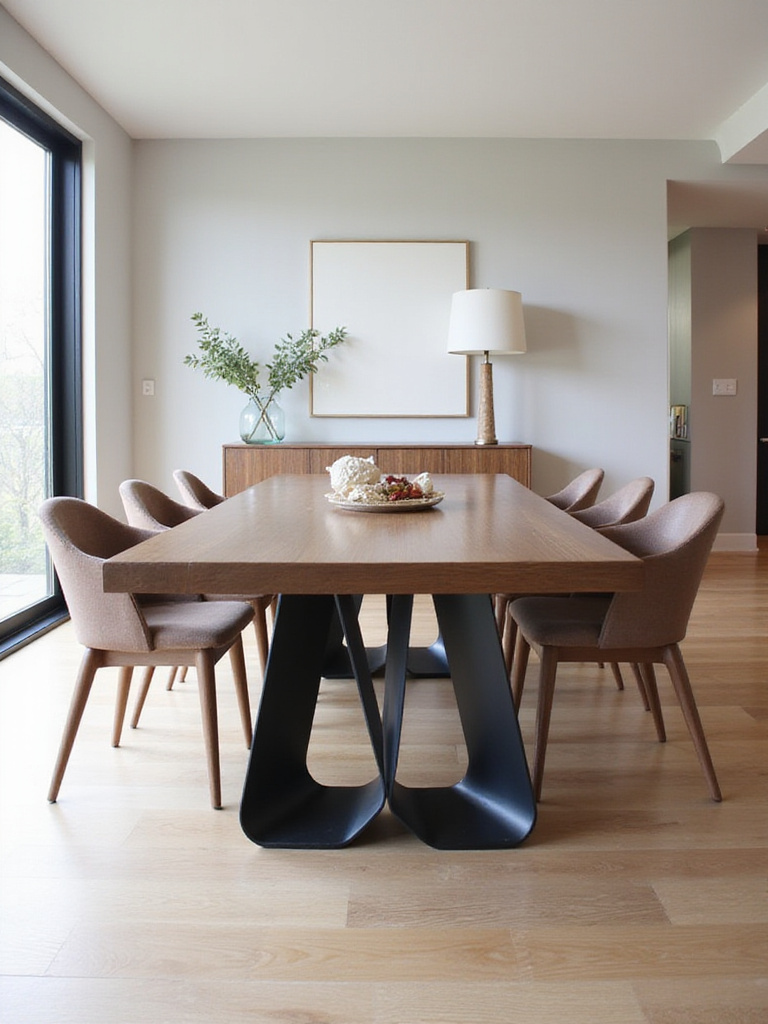
When selecting a table base for multi-generational dining, prioritize stability, clearance, and adjustability. Ensure adequate knee clearance (at least 27 inches high) for wheelchair users, with a base that doesn’t restrict movement underneath. Consider expandable options that accommodate varying family sizes for different gatherings. The material should balance beauty with function – perhaps a solid wood pedestal with subtle carved elements that connect to cultural heritage, or a contemporary design with rounded edges that’s safer for both young children and older adults with balance concerns.
Running your hand across this material reveals the thoughtful design considerations that make dining comfortable for everyone from toddlers to grandparents, creating a truly inclusive gathering space where no family member feels accommodated as an afterthought.
Often referred to as the ‘fifth wall,’ the ceiling presents a significant opportunity to address one of the biggest challenges in multi-generational dining rooms: acoustics. Many older adults use hearing aids that amplify all sounds indiscriminately, making conversation difficult in spaces with poor sound absorption. Meanwhile, children’s higher-pitched voices can create uncomfortable echo in rooms with hard surfaces. Enhancing the ceiling with acoustic-friendly materials can dramatically improve dining experiences for everyone.
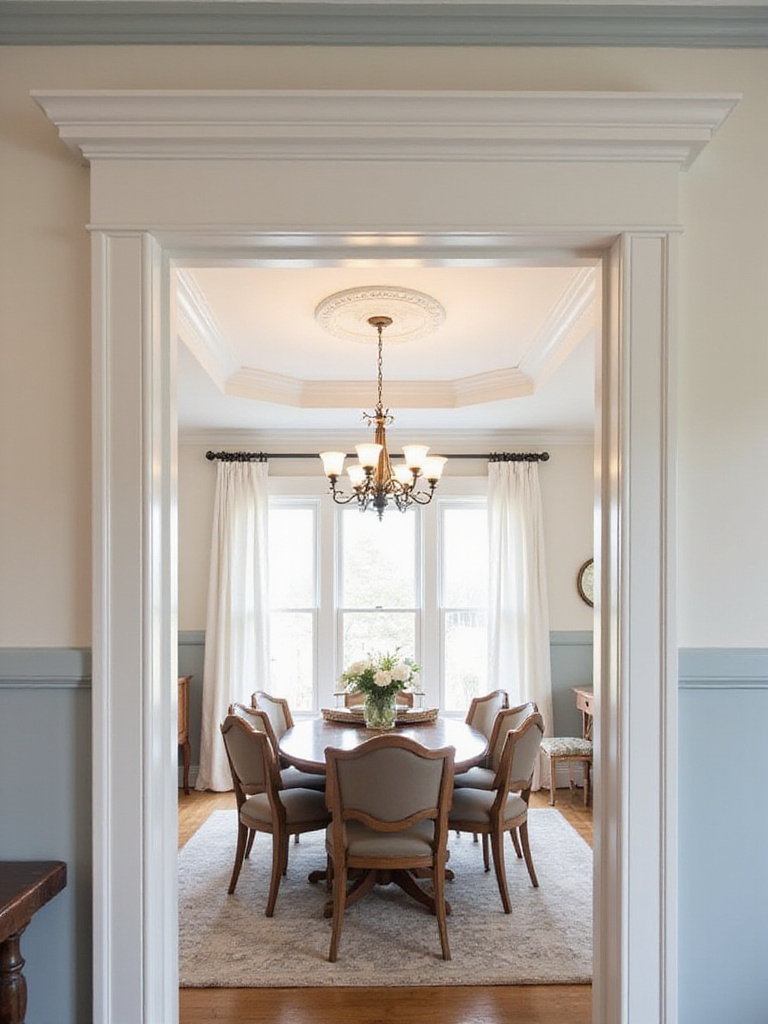
Consider coffered ceilings with sound-absorbing panels in the recesses, decorative ceiling tiles made from cork or other acoustic materials, or even fabric-wrapped panels that add both texture and sound dampening. The visual design can incorporate elements meaningful to family heritage – perhaps patterns inspired by traditional textiles or architectural details from ancestral homes. Color choices can enhance the room’s light quality, with lighter ceilings helping to reflect light downward (beneficial for aging eyes) while darker colors can create a sense of intimacy for evening gatherings.
The artisans behind these designs began with understanding how sound travels in dining spaces – work with specialists who understand both the aesthetic and functional aspects of ceiling treatments to create a space where conversation flows naturally across generations.
Open shelving offers a blend of functionality and cultural storytelling in multi-generational dining rooms. Unlike closed cabinets that hide possessions, open shelves create opportunities to display items that represent different family members’ contributions to the household’s identity – from grandmother’s traditional cooking vessels to parents’ wedding china to children’s handmade pottery. This visual accessibility helps younger generations connect with their heritage while giving elder family members the joy of seeing cherished items in daily use.
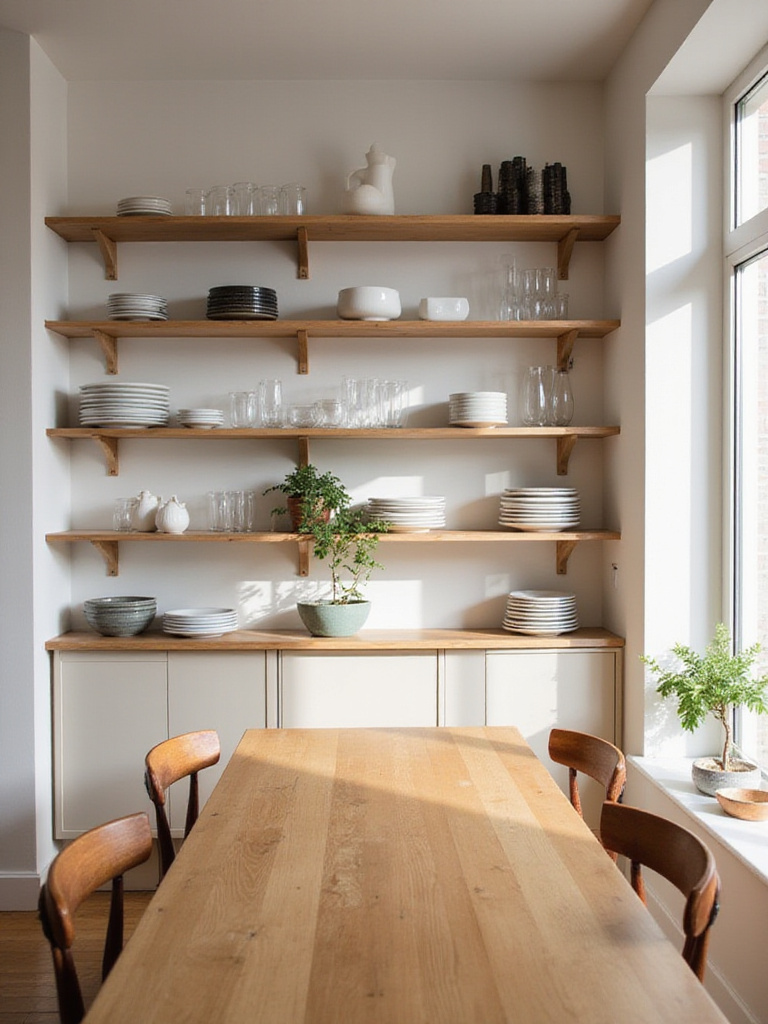
Items that work best for display in multi-generational homes combine beauty with meaning – the teapot used for morning rituals, special occasion serving pieces with stories attached, cookbooks passed down through generations with handwritten notes in margins, or collections that represent family travels or cultural background. Consider organizing shelves to tell your family’s story – perhaps chronologically showing items from different eras, geographically grouping items by country of origin, or functionally arranging items used in traditional cooking methods or celebrations.
“Our open shelving displays cooking vessels from four generations – my great-grandmother’s cast iron from Poland, my grandmother’s enamelware from her first American apartment, my mother’s copper pots from France, and my contemporary collection. Cooking together means reaching across time.” – Eva M., multi-generational home cook
The cultural heritage preserved in each piece includes not just the object itself but the practices and traditions associated with it – create opportunities for older family members to demonstrate traditional uses of displayed items, passing knowledge alongside physical heirlooms.
Upholstered seating significantly enhances comfort for family members of all ages, particularly important in multi-generational homes where meals often extend beyond quick eating to become extended family time. For older adults, proper cushioning reduces discomfort during longer seated periods, while younger family members benefit from the softened acoustics that upholstery provides. The right upholstered seating creates an environment where no one feels rushed to leave the table due to discomfort.
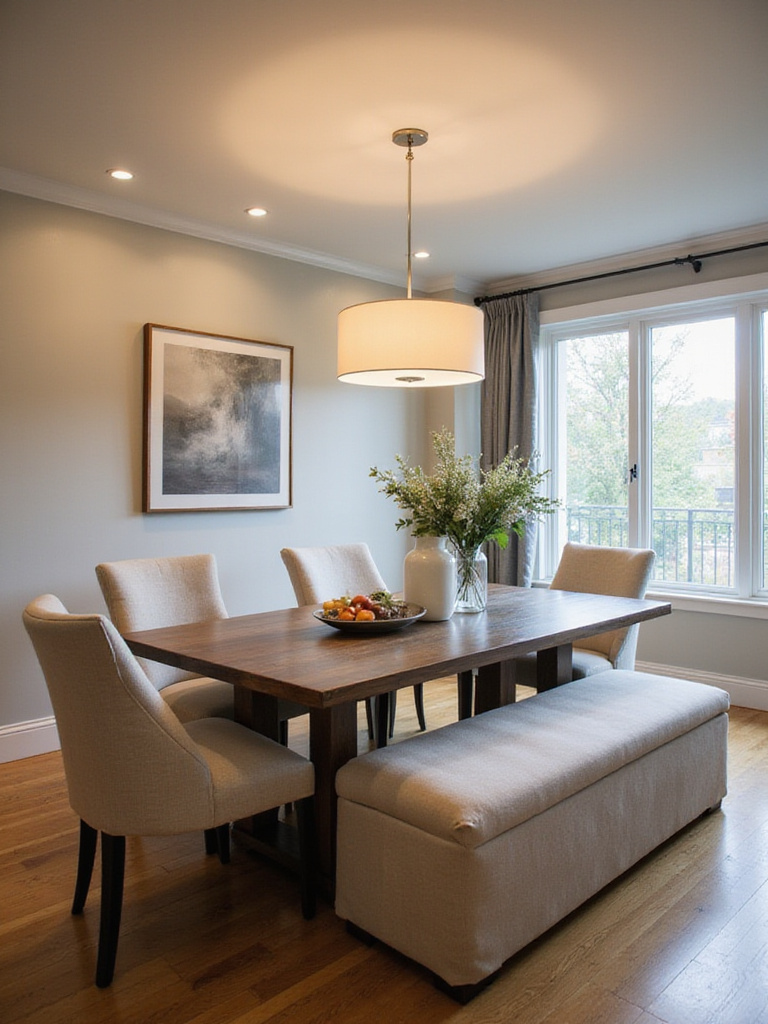
Different generations have distinct seating needs that can be addressed through thoughtful upholstery choices. For older adults, consider higher seat heights (19-21 inches versus the standard 18 inches) with firm cushioning that makes rising easier. Armrests provide stability when sitting and standing. For middle generations, ergonomic support for backs prevents discomfort during long family meals. For children and younger adults, stain-resistant performance fabrics ensure spills don’t create tension. Mixing these features through different chairs around the table addresses everyone’s needs while creating a collected, intentional look.
The design mistake most people make is prioritizing appearance over function – instead, start with the specific physical needs of your family members and then find beautiful upholstery options that address those requirements without sacrificing style.
Layered Lighting involves using multiple sources at different levels and intensities, crucial in multi-generational dining rooms where visual needs vary dramatically. Research shows older adults typically need 2-3 times more light than younger people for the same visual tasks, yet they’re also more sensitive to glare. Meanwhile, children and younger adults may prefer softer, more atmospheric lighting for certain activities. A well-designed lighting scheme accommodates everyone without requiring constant adjustments.
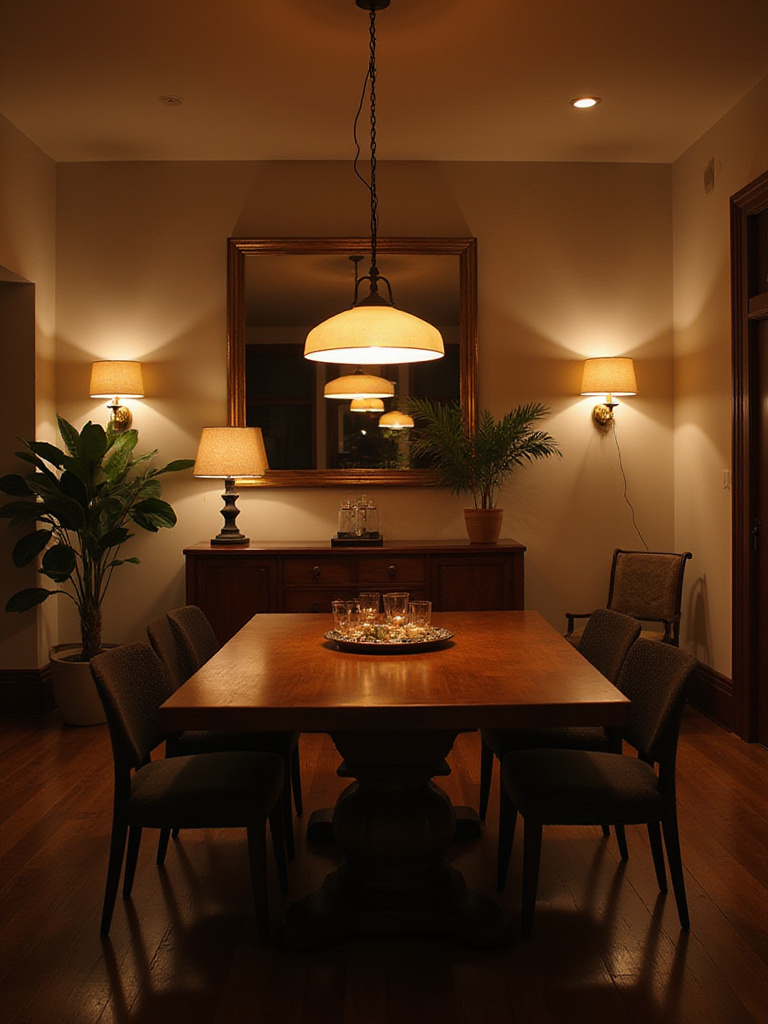
The primary layers should include ambient lighting from overhead fixtures, task lighting focused on the table surface, accent lighting highlighting art or architectural features, and decorative lighting adding atmosphere. Each layer should be independently controlled with dimmers. Consider color temperature carefully – warmer light (2700-3000K) is generally more flattering and comfortable for all ages, while cooler temperatures can create harsh conditions particularly challenging for aging eyes. Positioning is equally important – ensure light sources don’t create direct glare for seated diners of any age.
When your existing decor doesn’t seem to coordinate, lighting can create the unifying element – select fixtures that incorporate design elements meaningful to different generations, perhaps blending traditional forms with contemporary materials to create bridges between different family members’ aesthetic preferences.
Incorporating seasonal decor breathes fresh life into your dining room throughout the year while creating opportunities to pass down cultural traditions and family customs to younger generations. In multi-generational homes, seasonal changes in decor often mark important rhythms of family life, connecting to agricultural traditions, religious observances, or cultural celebrations that strengthen intergenerational bonds through shared practices and visual cues.
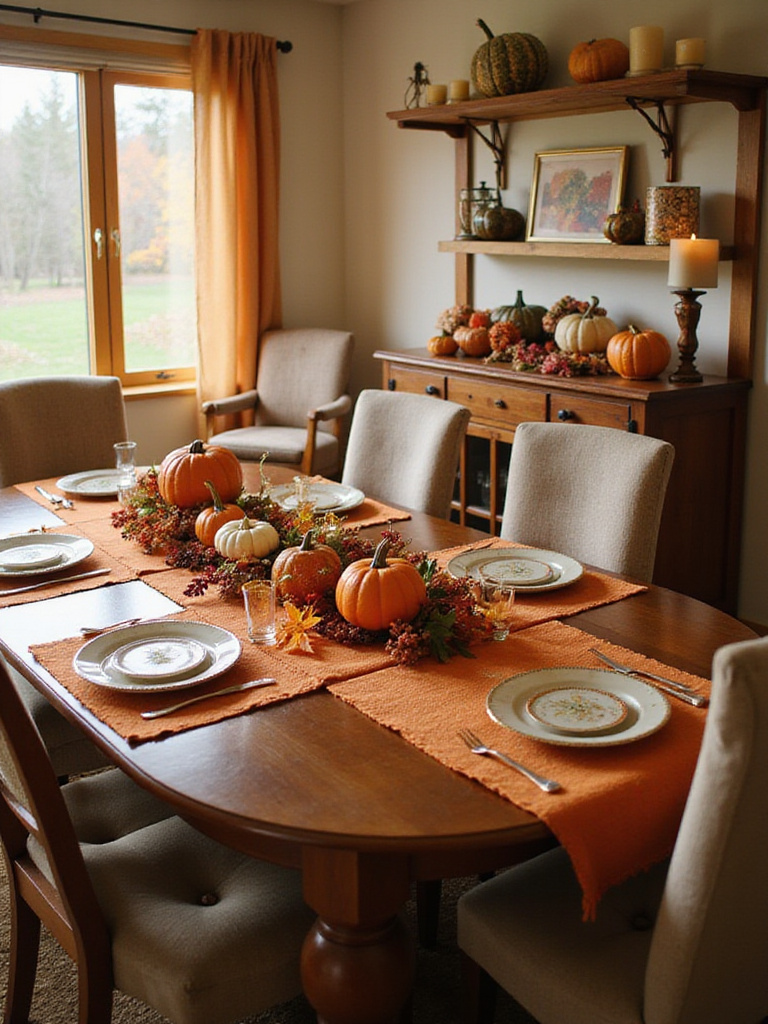
The most meaningful seasonal touches in multi-generational homes connect to specific family traditions rather than generic holiday decor. Consider creating dedicated storage for heirloom seasonal items with labels explaining their significance – grandmother’s special Diwali decorations, the Passover seder plate used for generations, harvest decorations that marked the end of growing seasons in ancestral homelands. Involve all generations in the process of seasonal changes, creating rituals around bringing out special items and sharing their stories. This practice becomes particularly valuable for families blending different cultural traditions or honoring multiple heritage backgrounds.
This season’s design language speaks to the blending of old and new – create opportunities for younger generations to contribute contemporary interpretations of traditional seasonal decorations, allowing family traditions to evolve while maintaining their essential cultural connections.
A china cabinet in a multi-generational home serves as both functional storage and a visual anchor that connects family members to their shared history. Beyond its practical purpose housing dinnerware and serving pieces, it becomes a repository of family stories and cultural heritage. The right cabinet makes these treasures both visible and accessible, allowing items to be appreciated daily while being available for use during special occasions.
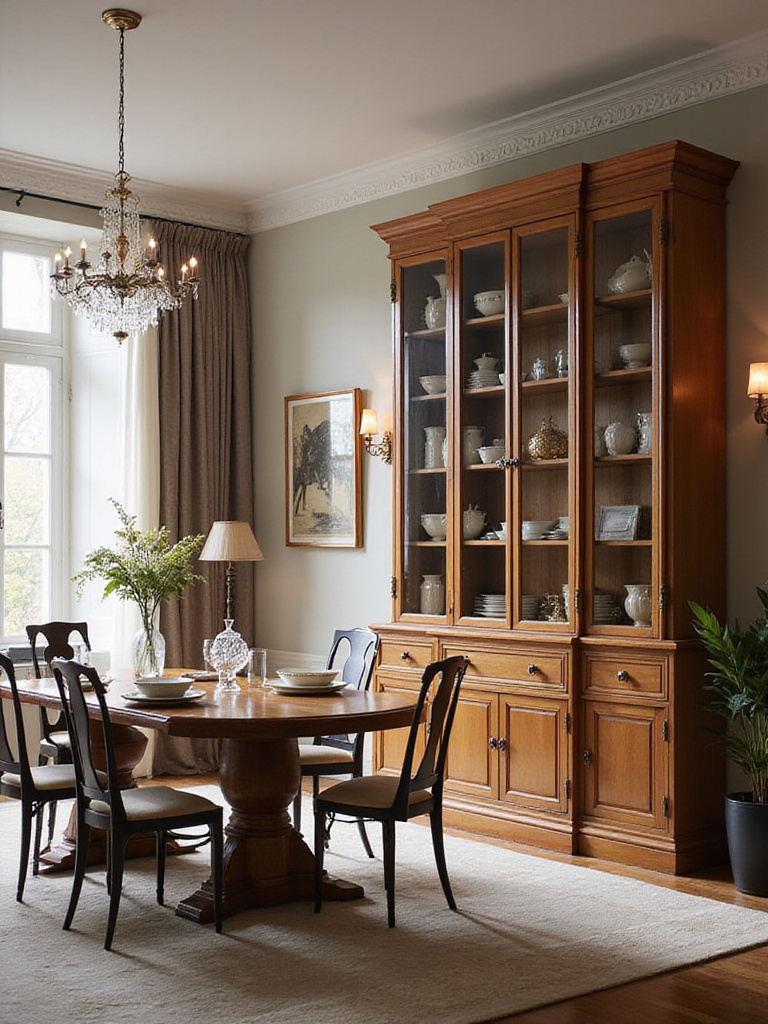
When selecting a china cabinet for a multi-generational dining room, consider features that accommodate diverse needs. Adjustable shelving allows customization as collections grow or change. Glass-front sections make items visible even to family members with mobility limitations who might not be able to open doors easily. Lower drawers can store items needed by younger family members, while higher shelves safely display fragile heirlooms. Look for cabinets with varying storage types – some open shelving for frequently used items, glass-front sections for display, and closed storage for practical necessities.
The maker’s journey from apprentice to master influenced how we think about displaying family treasures – organize your cabinet to show the evolution of your family’s story, from ancestral pieces to contemporary additions that represent the continuing family narrative.
Creating a dining room that serves multiple generations isn’t just about selecting beautiful decor—it’s about crafting a space where family stories can unfold across time. Each element, from the lighting that illuminates grandmother’s face as she shares wisdom to the chair that supports her comfortably, contributes to an environment where connections flourish and traditions pass smoothly between generations.
The most successful multi-generational dining rooms balance practicality with meaning, creating spaces where no family member feels like an afterthought. By incorporating elements that honor your unique family heritage while addressing the practical needs of everyone from toddlers to elders, you transform a simple eating space into the true heart of a multi-generational home—a place where the past is honored, the present is enjoyed, and the future takes shape through meaningful connection around the shared table.